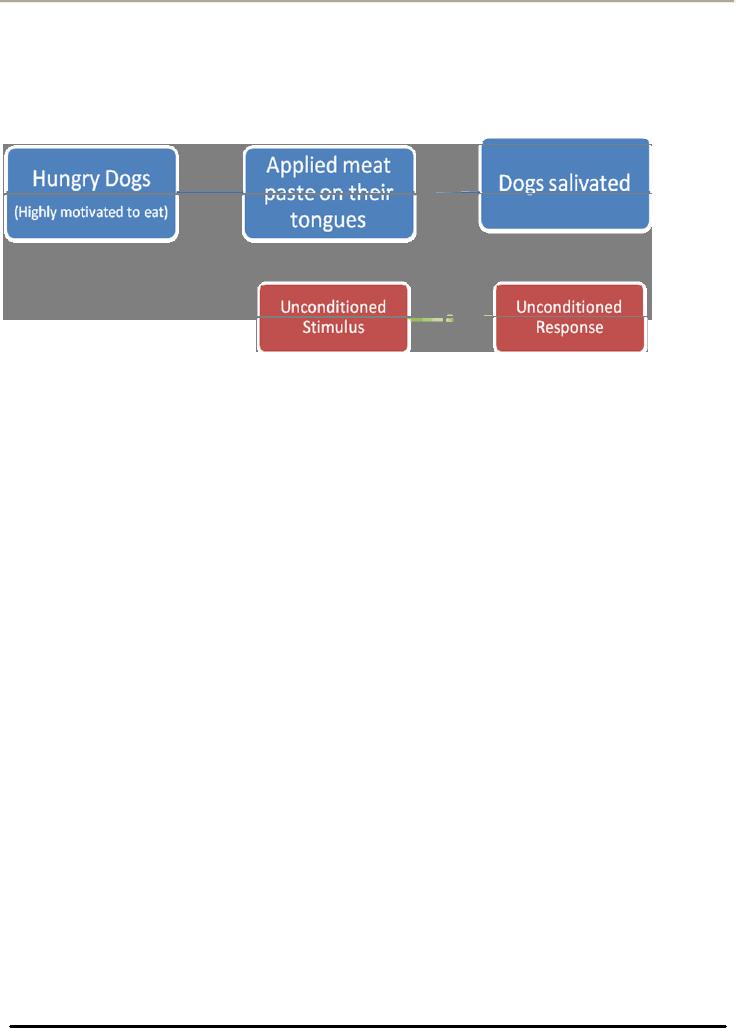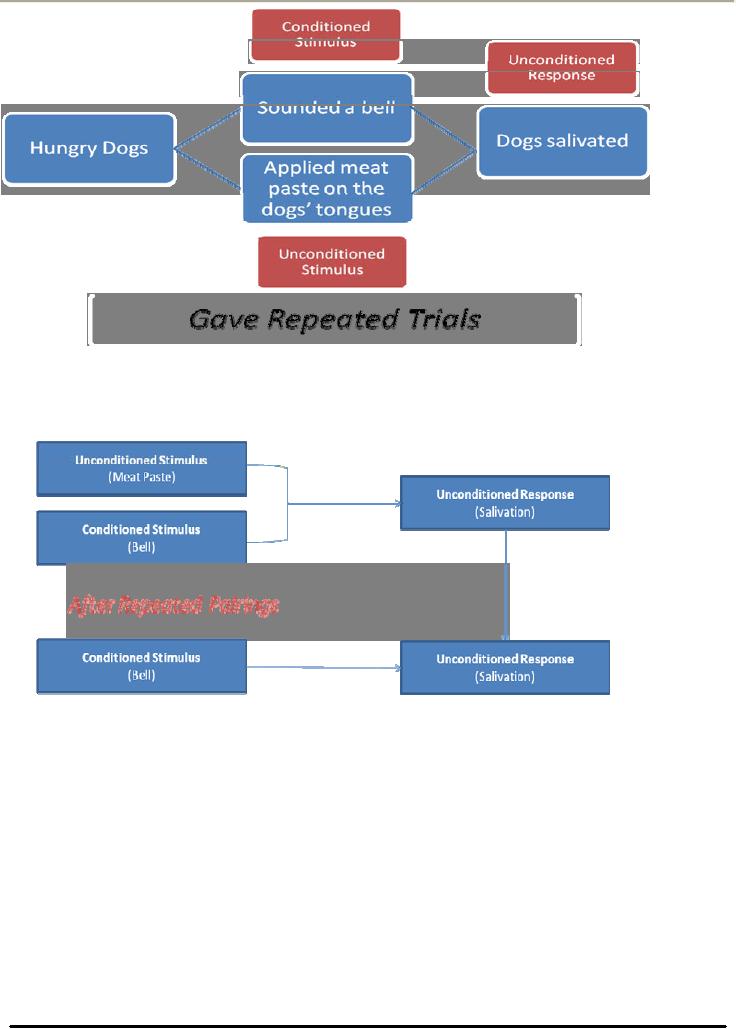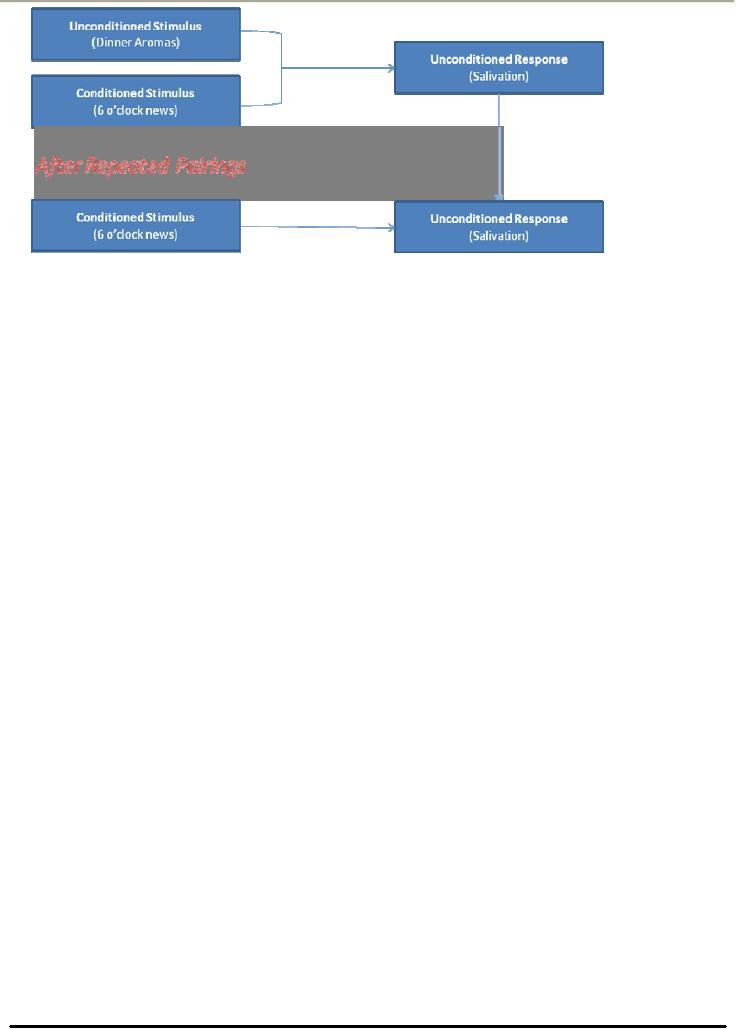 |

Consumer
Psychology (PSY -
514)
VU
LESSON
31
UNDERSTANDING
LEARNING
CHAPTER
5: INDIVIDUAL DETERMINANTS OF CONSUMER
BEHAVIOR
Understanding:
�
The
elements of Consumer Learning
�
Motivation
�
Cues
�
Reinforcement
�
Behavioral
Learning theory
�
Classical
Conditioning
Learning
Marketers
are concerned with how
individuals learn because they want to
teach them in their roles as
consumers
about
products; product attributes how to
maintain products, what are products'
potential benefits, where to
buy
them,
how to buy them, how to
maintain them and how to dispose of
them.
Marketers'
vital interest lies in
teaching consumers effectively to
prefer their brands and
differentiate their products
from
the competitive offerings.
Marketing
strategies are based on communicating
with consumers:
Directly
:through
advertisements
Indirectly:
through product appearance
and packaging, product
distribution channels and,
pricing
Marketers
want their communication to be noted, believed,
remembered and recalled by the
target potential
consumers
segments.
Learning
about Learning
Not
all theorists agree on how
learning takes place it is difficult to
come up with a generally
accepted definition of
learning,
however, Consumer Learning can be thought
of as:The process by which
individuals acquire the
purchase
and
consumption knowledge and experience that
they apply to future related
behavior
Consumer
learning is a process that continually
evolves, and changes. The
change is because of the newly
acquired
knowledge
(gained from reading,
discussion, observation and thinking or
factual experience). Newly
acquired
knowledge
and personal experience
serve as feedback. Feedback provides
basis for the future
behavior in similar
situations
Intentional
and Incidental Learning
Intentional
Learning is acquired as the result of
careful search for
information. Incidental Learning is
acquired by
accident
without much effort. For
example some ads may
induce learning e.g. new products under
familiar brand
names,
even the consumers attention
may be on a magazine article rather than
advertisement on the facing
page.
Other
ads are sought out
and carefully read by consumers
contemplating a major purchase
decision.
Range
of Learning
The
term learning encompasses the total range
of learning from simple almost
reflexive responses to learning
abstract
concepts and complex problem solving.
All theorists agree that
for learning to occur certain
basic
elements
must be present. These
include:
Motivation
Cues
Response
Reinforcement
100

Consumer
Psychology (PSY -
514)
VU
1.
Motivation
Motivation
is the drive that impels and
individual to action. Motivation is based
on needs and goals. It acts
as spur
of
learning.
Involvement
Theory
Men
an women who want to take up
bicycle riding for fitness
and recreation are motivated
to learn all they can
about
bike riding and practice
often. Conversely individuals
who are not interested in
bike riding are likely
to
ignore
all information about bike
riding. The degree of
relevance or Involvement determines
consumer's level of
motivation
to search for knowledge and or
information about the product or service.
This is called the
Involvement
Theory.
Implications
for Marketers
Uncovering
the consumer motivation is one of the
prime tasks of marketers, who
try to teach motivated
consumer
segments
why and how their
products will fulfill
consumer needs
2.
Cues
If
motives serve to stimulate learning,
cues are the stimuli that
give direction to these motives. An
exotic trip that
includes
bike riding may serve as a
cue for bike riders
who may suddenly recognize
that they need a vacation.
The
ad
is the cue or stimulus that
suggests a specific way to
satisfy a salient motive. In the
market styling, packaging
and
store display all serve as
cues to help consumers to
fulfill their needs in
product specific
ways.
3.
Responses
How
individuals react to a drive or a
cue how they behave- constitute
their response is important.
Equally
important,
however, is that learning can occur
even when responses are not
overt.
Need
or motive may evoke a whole variety of
responses. Cues provide some
direction but there are so
many cues
competing
for the consumer's attention. Which
response the consumer makes
depends heavily upon previous
learning
that in turn depends upon
how the previous response has
been reinforced.
4.
Reinforcement
Reinforcement
increases the likelihood that a
particular response will occur in the
future as the result of particular
cues
or stimuli. A product that fulfills the
basic need will reinforce the
purchase behavior and the
consumer will
most
likely purchase it
again.
Behavioral
Learning Theories
Behavior
Learning Theories are sometimes referred
to as "Stimulus Response Theories". These
are based upon the
premise
that observable responses to
specific external stimuli signal
learning. A child who relaxes at the
image of
his
uncle has learnt the attachment
with uncle. Behavior theories
are concerned with inputs
and outputs of
learning.
There are two types of behavioral
learning theories popular with the
marketers.
Types
of Behavioral Learning
Theories
Generally,
there are two types of
behavioral learning theories:
Classical
Conditioning
Instrumental
(Operant Conditioning)
Conditioning
means
response to a situation built up
through repeated exposure.
Ivan Pavlov a Russian
Psychologist
was the first to describe
conditioning and to propose it as a
general model of how learning
occurs.
Pavlovian
Experiment
Pavlov
conducted his famous
conditioning experiments in the following
three stages:
Stage
1: Unconditioned
Stimulus and Unconditioned
Response
101

Consumer
Psychology (PSY -
514)
VU
Stage
2: Repeated
Trials of combining conditioned
stimulus with Unconditioned
Stimulus conditioned
102

Consumer
Psychology (PSY -
514)
VU
Overview
of the Experiment
Implications
for Marketers
103

Consumer
Psychology (PSY -
514)
VU
Three
Strategic Applications of Classical
Conditioning
Three
strategic applications of Classical
conditioning include:
Repetition
Stimulus
Generalization
Stimulus
Discrimination
1.
Repetition
Repetition
increases the strength of association
between a conditioned stimulus
and a conditioned
response.
Researchers
suggest there is a limit to
repetition to aid retention.
Some scholars believe that
just three exposures
to
an
advertisement are needed. This is
called, Three
Hit Theory
The
three exposures to an advertisement
pertain to:
1.
Make consumer aware of the
product
2.
Show consumer the relevance of the
products
3.
Remind them of product
benefits
Others
think It may take 11 to 12
hits. Effectiveness of repetition
may also be dependent upon the
competitive
advertising
to which consumer is exposed.
The higher the level of competitive
advertising, greater is the
likelihood
that
Interference will take
place, causing consumers to
forget previous information.
At
some point individual can
become satiated with
numerous exposures. The effect is
known as Advertisement
Wear
Out. To
deal with this phenomenon following
measures are usually
used:
Cosmetic
Variations: Using
different backgrounds, different
print types and different
spokespersons while
keeping
the theme same
Substantive
Variations: Changes
in advertisement content across different
variations of ads e.g. two
ads that
stress
two different attributes of the same
product
2.
Stimulus Generalization
Classical
conditioning theorists believe
that learning also depends
upon Stimulus Generalization
that
means making the same response to
somewhat similar stimuli as the
conditioned stimulus
Dog
could learn to salivate not
only to the conditioned stimulus of
bell but also to the jangling of
keys
Implications
for Marketers
Me-Too
products
are the cheap copies of some
established brand of a product. Some
times Me-too products
succeed
because of the stimulus generalization.
Consumers confuse them with
original products they have
seen
before.
Many Cola drinkers can't
differentiate between different
brands
104

Consumer
Psychology (PSY -
514)
VU
3.
Stimulus Discrimination
Stimulus
Discrimination is the opposite of Stimulus
Generalization and results in the
selection of specific
stimulus
from
amongst the similar stimuli. The
consumers' ability to choose
from amongst the similar
stimuli is the basis of
positioning.
105
Table of Contents:
- INTRODUCTION TO CONSUMER PSYCHOLOGY:Consumer Behavior
- INTRODUCTION TO CONSUMER PSYCHOLOGY:Consumer research
- INTRODUCTION TO CONSUMER PSYCHOLOGY:Marketing Mix, Product, Price
- INTRODUCTION TO CONSUMER PSYCHOLOGY:Customer Value, Perceived Value
- VALUE AND RETENTION FOCUSED MARKETING AND CONSUMER DECISION MAKING PROCESS
- CONSUMER RESEARCH:Quantitative Research, Qualitative Research
- MAJOR STEPS IN CONSUMER RESEARCH PROCESS:Design of Primary research
- QUANTITATIVE RESEARCH DESIGNS & DATA COLLECTION METHODS
- QUANTITATIVE RESEARCH DATA COLLECTION TECHNIQUES:ATTITUDE SCALES
- QUALITATIVE RESEARCH DESIGNS & DATA COLLECTION METHODS
- CUSTOMER SATISFACTION MEASUREMENT, SAMPLING, AND DATA ANALYSIS AND REPORTING
- MARKET SEGMENTATION AND ITS BASES:Geographical Segmentation
- BASES FOR SEGMENTATION: DEMOGRAPHIC SEGMENTATION PSYCHOGRAPHIC SEGMENTATION
- BASES FOR SEGMENTATION: SOCIOCULTURAL SEGMENTATION USE RELATED SEGMENTATION USAGE SITUATION SEGMENTATION
- BASES FOR SEGMENTATION: BENEFIT SEGMENTATION:Intrinsic Cues
- BASES FOR SEGMENTATION: HYBRID SEGMENTATION STRATEGIES
- MARKET SEGMENTATION IMPLEMENTING SEGMENTATION STRATEGIES ENVIRONMENTAL INFLUENCES CULTURE
- HOW CULTURE IS LEARNT ENVIRONMENTAL INFLUENCES:Formal Learning
- CULTURE AND ITS MEASUREMENT ENVIRONMENTAL INFLUENCES
- MEASUREMENT OF CULTURE ENVIRONMENTAL INFLUENCES:Consumer Fieldwork
- SUBCULTURE CHAPTER 4: ENVIRONMENTAL INFLUENCES
- AGE AND GENDER SUBCULTURE CHAPTER 4: ENVIRONMENTAL INFLUENCES
- BASES FOR SEGMENTATION: BENEFIT SEGMENTATION:Market Segmentation
- SOCIAL CLASS CHAPTER 4: ENVIRONMENTAL INFLUENCES:Occupation
- CONSUMER SOCIAL CLASSES CHAPTER 4: ENVIRONMENTAL INFLUENCES:Affluent Consumer
- CONSUMER SOCIAL CLASSES CHAPTER 4: ENVIRONMENTAL INFLUENCES:Membership Group
- CONSUMER SOCIAL CLASSES CHAPTER 4: ENVIRONMENTAL INFLUENCES:Shopping Groups
- UNDERSTANDING PERSONALITY CHAPTER 5: INDIVIDUAL DETERMINANTS OF CONSUMER BEHAVIOR
- CONSUMER PERSONALITY, TRAIT THEORY AND SELF IMAGES
- CONSUMER MOTIVATION:Needs, Goals, Generic Goals
- UNDERSTANDING LEARNING:Intentional and Incidental Learning, Implications for Marketers
- INSTRUMENTAL CONDITIONING, INFORMATION PROCESSING AND MEMORY
- ATTITUDES:Characteristics of Attitudes, Attitudes have consistency
- ATTITUDE FORMATION AND CHANGE:How attitudes are learned?
- ATTITUDE CHANGE STRATEGIES:Resolving two conflicting attitudes
- INTRODUCTION TO CONSUMER DECISION MAKING:Decision Complexity
- Problem Recognition, Search and Evaluation and Decision and Purchase
- Decision and Purchase:Consumer Decision Rules, Output, Relationship Marketing
- Decisions Related to Post Purchase:Product Set up and Use
- Marketing Implications of Decisions Related to Post Purchase:Understanding
- Post Purchase Evaluation:Determinants of Satisfaction, Consumer Complaint Behavior
- Post Purchase Dissonance:Dissonance Reduction, Marketing Implications
- Consumerism:Roots of Consumerism, The Nature of Consumerism
- Consumerism – Issues and Responses:Environmental Concerns, Consumer Privacy
- Review – Consumer Psychology Course:Consumer Research, Consumerism